When you live in the Languedoc you are surrounded by vines. They are everywhere and form the world’s biggest vineyard area, producing one third of all France’s wine. Vines stretch over hill and valley, coastline and plains. As you walk around it is easy to think of vines as all being the same, part of one big plantation, but when we have received visitors and we go on walks through the vineyards they often ask me what sort of vine we are passing. Cue guesswork on my part unless I am in the vineyards of Mas Coutelou. To remedy this ignorance and to meet the brief at the top of this blog that I should be “learning about wine, vines and vignerons” I set myself the challenge of being able to identify the main types of vine in the region.

Ampelography is the study of identifying and classifying grapevines. There are many learned books on the subject, some running to hundreds of pages. However, I wanted a simple guide, to learn the basic varieties before expanding to others. I took some photographs in the parcels of vines of Mas Coutelou and using the internet and Jeff himself I hope I have put together a simple reference piece. As we enter harvest it has proved useful to me so that I know what I am picking or sorting. Hopefully it will be useful to you too, whether you visit vineyards or just take an interest in wine and vines.
Experts use features such as the shape of the grape bunches, size and colour of the grapes. However, for me the most obvious way of distinguishing between vines are the shape of the leaves.
The colour of leaves varies but so too the number of lobes (from just one to seven), the colour of the veins and the shape of the sinus around the stalk (pétiole). The sinus is the gap between the lobes. So here is my simple guide to identifying some Languedoc vines. I have started in this post with the five main red wine varieties.
Red wine vines
Syrah
Syrah is one of the great varieties of the Languedoc. Famous for its wines in the Rhone Valley and around the world (Shiraz in Australia) Syrah produces great wines here too. The leaves are quite a light green in colour with 5 lobes which are well separated out including a big sinus (V shaped) around the stalk (pétiole). The veins are quite light and stand out. The leaf edge has small, gentle teeth shapes. The grapes tend to be oblong shaped and fairly small in size. Syrah is one of the earlier red varieties to ripen.
Recommended wines:
Mas Coutelou – La Vigne Haute
Others – Sylvain Bock, Raffut; Plan De L’Homme, Alpha; Haute Lignières, Sur Le Fil; Terre Inconnue, Sylvie
Grenache
A variety which loves the heat, very much a Spanish and Mediterranean grape. Grenache leaves have a more round appearance than Syrah with big, wide lobes which are not so separated as the Syrah giving the impression of a big, whole leaf. There is a wide sinus around the stalk. The leaf edges have saw teeth which are quite marked. Light veins and round, medium sized grapes. Grenache is a late ripening variety. Often used to blend it is not often used for single variety wines.
Mas Coutelou – Grenache, Mise De Printemps
Others – Engelvin, Même-Si and Vieux Ronsard; Treloar, One Block Grenache;
Mourvèdre
Mourvèdre is a late ripening and, sometimes, a difficult grape to ripen. The lobes are broad and form three rather than five as you can see in the photo on the right of the page above. There is a little green colouring in the veins and the sinus around the stalk is a lyre shape. The teeth around the edge are distinct and quite big all around. The grapes come in biggish bunches though the grapes are medium in size.
Mas Coutelou – Sauvé De La Citerne
Others – Clos Fantine, Cuvée Courtiol; La Liquière, Tucade; Treloar, Motus
Carignan
Carignan has big leaves which are quite hairy underneath and have a more dimply appearance than most in the upper surface. Five lobes usually though in the photo above the lower lobes are small with big upper lobes and a distinct top lobe. The teeth are tapered and distinct. The veins are hardly coloured. This is a late ripening variety and you can see the grapes below which are still turning black, even though this was taken at the same time as the other photos. The grapes and clusters are medium to large in size.
Mas Coutelou – Flambadou
Others – Mas Des Capitelles, Loris; Coume Mayou, La Loute Mas Gabriel, Trois Terrasses Deux Ânes – L’Enclos
Cinsault
I like to think of Cinsault leaves as being very like the grape’s flavours, open, friendly and welcoming. These are big widely spaced lobes and a deep, open sinus around the stalk. The veins are light and clear and the teeth are big, almost rounded which cover all the leaf edge. Often used in rosé wines Cinsault is starting to be used to make some great red wines in the region.
Cinsault grapes are big and form big clusters.
Mas Coutelou – 5SO and Copains
Others – Pelletier, L’Oiselet; La Fontude, Fontitude; Thierry Navarre, L’Oeillade Julien Peyras, Gourmandises

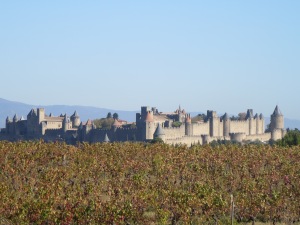

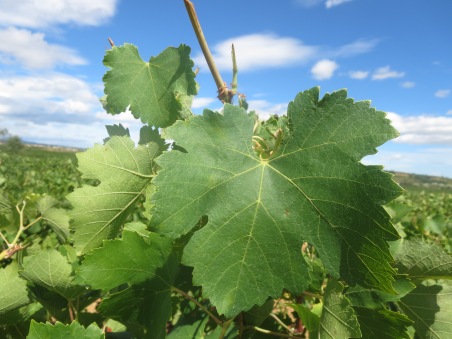
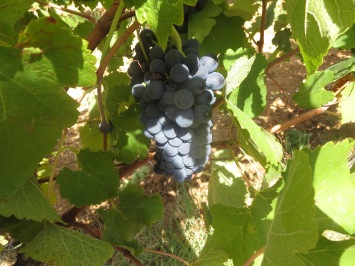
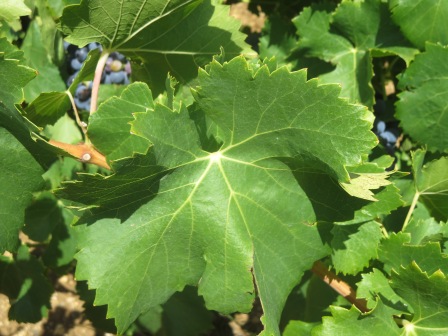
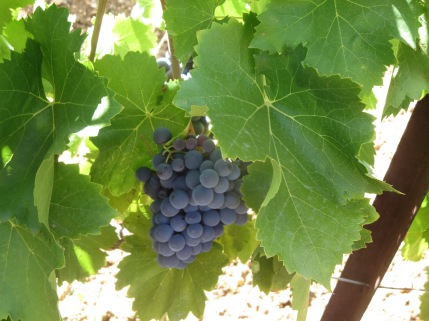
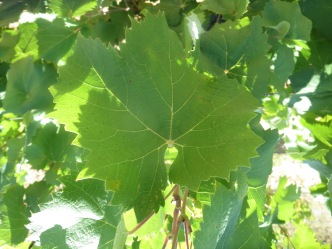
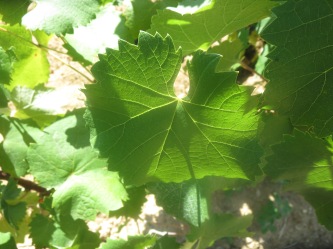
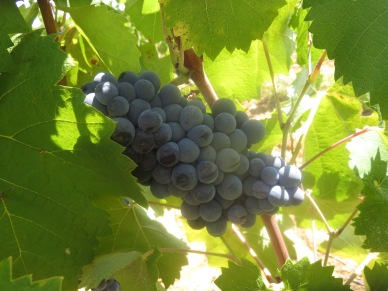

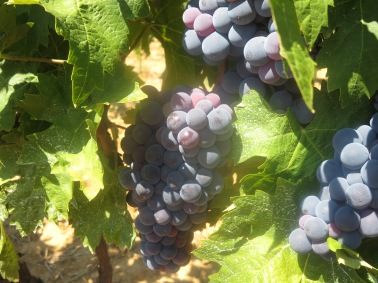

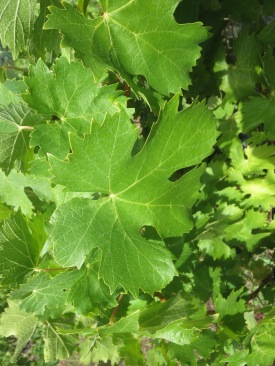
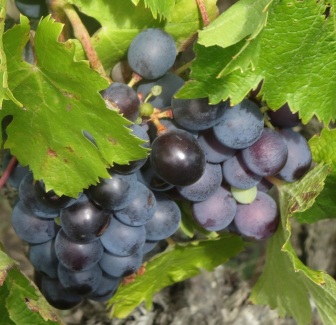

August 24, 2015 at 5:36 pm
As someone who tries to give the impression of knowing something about wine, I’m happy to admit I’m pretty useless at vine identification. Indeed, I’d love to learn. No amount of looking at the drawings in Jancis’s Vines, Grapes, Wines, nor the photos in the Wine Atlas have helped. I can tell a Titian from a Leonardo and can identify many a piece of music in seconds, but I could not tell Merlot from Cabernet, let alone Syrah from Carignan.
When a friend has taken over an allotment with a thousand bunches ripening under the Southern sun (Southern England in my case), an answer to his question, and that of the guy who is going to help us make it into wine, as to what we have there has not been forthcoming. It’s terrible Alan, but if I’m wholly honest I can’t really see any major difference between the leaves at the end of your post, even if I’ll admit to noticing differences in colour, grape size and bunch shapes for the grapes themselves. So if my senses of smell and taste are fine, maybe not my eyesight. Should have gone to Spec Savers!
LikeLiked by 1 person
August 24, 2015 at 6:22 pm
It is difficult David I admit. As you will see in part 2 there are some which are very clear, Cabernet Sauvignon especially. You will definitely be able to differentiate it from Merlot. Cinsault is very open, Grenache and Mourvedre are much more closed. When I did that little collage I realised it is quite hard to sort them out, but I felt it was something I should be able to do since I see them so often.
Mind don’t ask me to sort them out in winter!!
LikeLike
August 25, 2015 at 5:36 pm
Lovely photos Alan. Not sure I agree that Grenache is particularly late ripening, especially for making table wine. It does have the ability to go on ripening to make sweet VDN of course, like Muscat and Clairette.
They also say that Mourvedre has to have its roots in the Mediterranean in order to ripen.
LikeLiked by 1 person
August 25, 2015 at 10:08 pm
Thanks Graham. I based my comments on what I have read and also experience last year and this. Grenache was the last of the grapes to be picked last year, admittedly there were 3 passages through the main parcel and some was a bit earlier. Similarly this year it is the shyest of the reds in heading to maturity. Small sample so I could well be wrong, it certainly wouldn’t be the first time.
LikeLike
August 26, 2015 at 4:38 pm
Bizarre. Just picked a Grenache parcel at Ribiera that’s come in at 13.5% – deliberately picked in good time in order not to be too alcoholic. At Mas Gabriel the Grenache does ripen later but isn’t in the Carignan or Mouvedre league.
LikeLiked by 1 person
August 26, 2015 at 8:49 pm
The mystery of wine 🙂
http://www.vindefrance-cepages.org/en/encyclopedie-des-cepages-de-france-grenache-noir-16
“Budding and ripening
Grenache Noir buds relatively early, just 6 days after Chasselas, the benchmark, but ripens much later. Grenache Noir ripens 4 weeks after Chasselas, making it a Period IV grape variety.”
LikeLike